

USCG CABLE SHIP PEQUOT - UNITED STATES HARBOR
DEFENCES
These pages
continue the story of the U.S. Coast Guard Cable ship Pequot during World
War II as a harbor defense cable-laying and repair ship under direction of the
US Navy. She was responsible for the installation of anti-submarine
indicator loop cables, and
while laying and servicing standard communications cables, the Pequot
moved very slowly or was stationary. Primarily based out of Boston or New York,
a variety of escort vessels were assigned to protect Pequot during these
operations throughout the war. This is a story about service aboard one of the
83-Footer escort ships. For more information on 83-Footers and other Pequot
escorts see our
Pequot Escort page.
All photos, unless otherwise indicated, are courtesy of the Flanagan family.
Service Aboard an 83-Footer and the Thomas J Flanagan Jr. Story
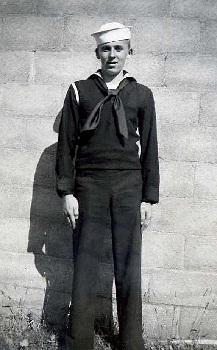 |
Thomas J Flanagan Jr. signed up into the United States Coast Guard Reserve on
October 1, 1942 and like many of our Pequot sailors went through
basic training at the Manhattan Beach Training Center in New York. After boot
camp he was assigned through the Boston receiving station to the Point Allerton
Coast Guard Base and Lifesaving Station at Hull, Massachusetts.
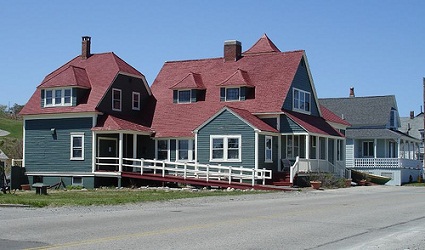 |
 |
|
The Point Allerton Life Saving Station opened in 1889 and has a long and colorful history. During WWII this Coast Guard base played a vital role in coastal and harbor defense along the coast of Massachusetts. (Photos Nantaskart & US Coast Guard) |
|
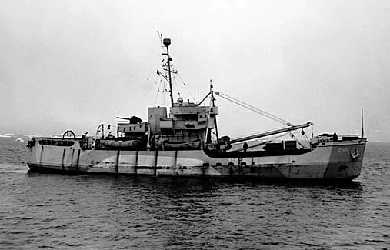 |
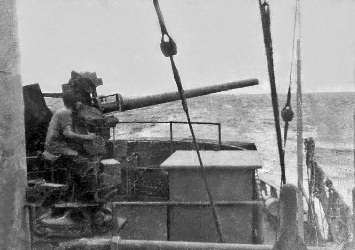 |
| USCG Evergreen (WAGL-295) (Isthmus Books) | (Thomas Flanagan Family) |
After shore assignments with the 3rd Naval District out of New York Flanagan’s first sea duty was aboard the Coast Guard buoy tender Evergreen (WAGL-295). The Evergreen was one of 39 original 180-foot seagoing buoy tenders built between 1942-1944. During wartime the ship was armed with 20-mm guns, a 3-inch cannon, and depth charges. On the right is a photo Thomas Flanagan took of a sailor manning the Evergreen’s 3-inch aft facing cannon.
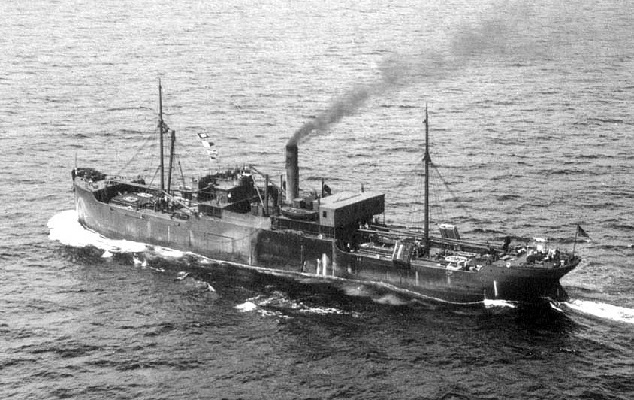 |
|
The USCG Asterion in her Q-Ship disguise as the SS Evelyn May 19th 1942 (USCG Photo) |
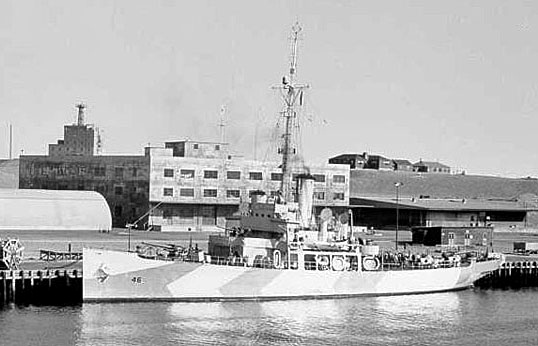 |
|
US Coast Guard Cutter Modoc in Harbor (US Coast Guard Photo) |
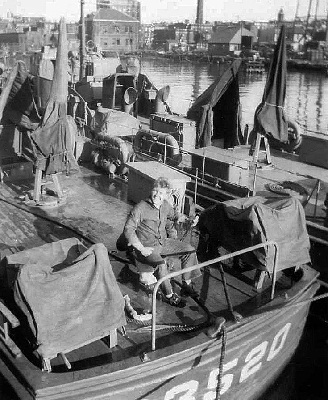 |
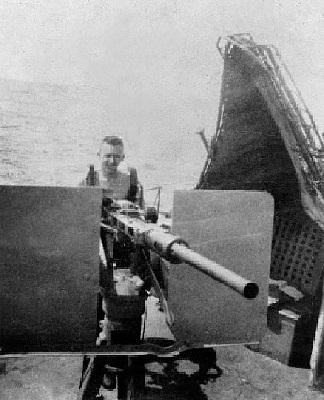 |
|
A sailor sitting aft on the CG-83520 between the two aft depth charge racks and another seaman on the 20mm Oerlikon. (Flanagan Family) |
|
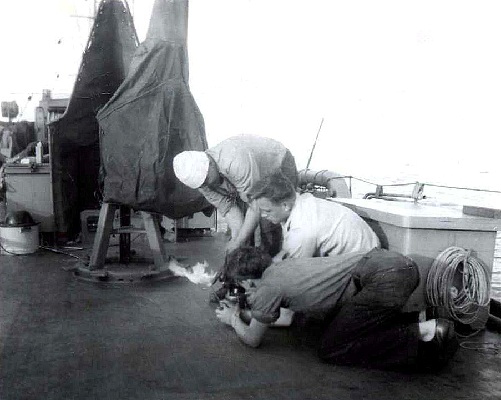 |
|
With the 20mm Oerlikon anti-aircraft gun covered behind them, we see three sailors working together with a torch to repair something on the rear deck of the CG-83520. |
 |
|
Here we see an 83 footer, possibly the CG-83520, being hoisted aboard a transport ship for the long transfer journey from the US East Coast to Manicani Island in the Philippines. |
In January of 1945 thirty 83-foot Coast Guard patrol boats, including the CG-83520 and CG-83521, were shipped to the 7th Fleet in the South Pacific to form "USCG PTC Flotilla Number One". They were stationed and operated out of Manicani Island, just south of the island of Samar near Leyte in the Philippines. Based upon the life saving success of the Coast Guard 83-footers of the “Rescue One Flotilla” who pulled wounded GIs off the beaches of Normandy during the June 6th 1944 invasion, the US was pre-positioning these 83-foot patrol boats in the South Pacific for the expected invasion of the Japanese mainland. After the war, like all of the Coast Guard 83-footers in the South Pacific, the CG-83520 that Thomas Flanagan served on was decommissioned in the Philippines and disposed of by the U.S. State Department.
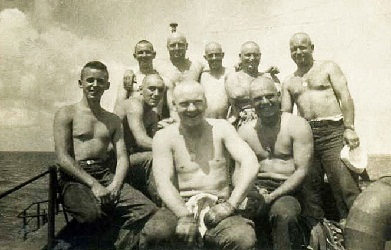 |
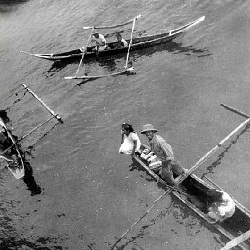 |
|
While in Manila in 1945 to beat the sweltering heat of the South Pacific the crew of the CG-83520 shaved their heads. Thomas Flanagan is the sailor on the far left. Local Pilipinos coming out to welcome US ships in the port of Luzon 1945. (Thomas Flanagan Family |
|
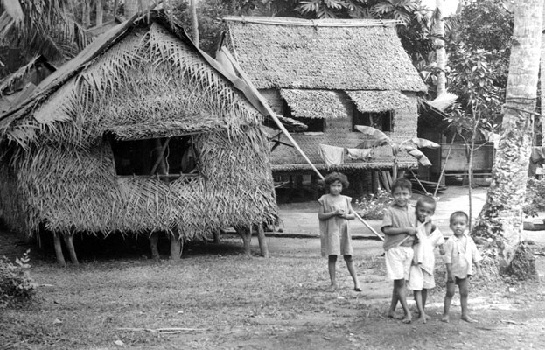 |
|
Manicani Island 1944 (Robert Houska / City of Cerritos) |
Flanagan’s son Tom tells us that his Dad always said the beach in Manila looked like a junk yard with so many wreaked Japanese and American planes that were shot down, some by friendly fire. He father told how he and some of the CG-83520 crew members painted Japanese Zero markings over the US stars on the wings of some downed U.S. aircraft. He also said that on the day the atomic bomb was dropped on Hiroshima that the sky and the light was just not right. It appeared a strange hazy gray and the ocean was like a sheet of glass.
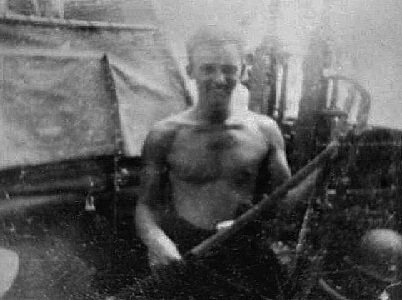 |
 |
|
Thomas J. Flanagan Jr. aboard the CG-83520 in the South Pacific with a captured Japanese Samurai Sword and a photo he took of bomb damage to Manila City Hall. (Thomas Flanagan Family) |
|
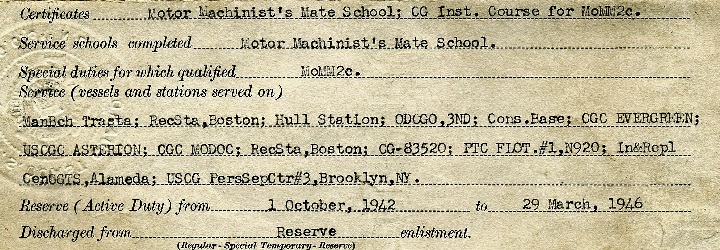 |
|
Thomas J. Flanagan Jr.’s service record on the back of his Honorable Discharge. |
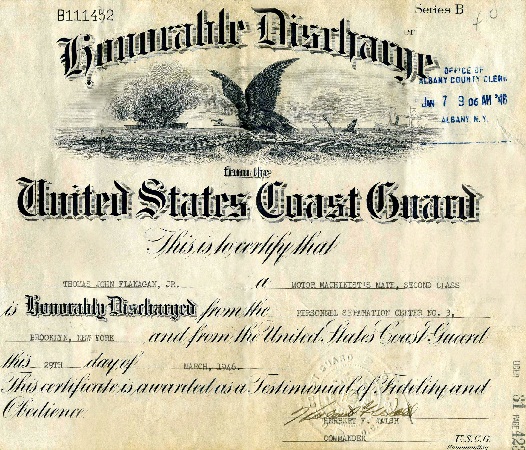 |
After serving in conditions that varied from the icy North Atlantic to the blistering heat of the South Pacific, at the Coast Guard Personnel Separation Center in Brooklyn, New York Thomas Flanagan Jr. was discharged on March 29th 1946.
After the war Tom Flanagan worked as a union steam fitter with Local 7 in Albany, New York. He remained good friends with Bob Michaels of Brooklyn, New York who was the skipper of the CG-83520.
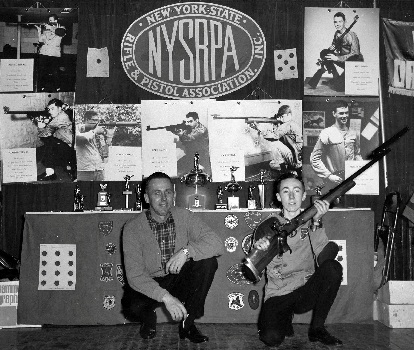 |
|
Thomas Flanagan with his son Tom in 1966 during a New York State Rifle and Pistol Association event. |
His son Tom remembers going with his father to meet Michaels on his fishing boat in Sheepshead Bay, New York and how one day his Dad used a Japanese machine gun to shoot crows off the top of his barn but ended up missing the birds and taking off a lot of roof.
Tom Flanagan passed away in 2008 at the age of 83.
Every effort has been made to trace and acknowledge copyright. The authors would welcome any information from people who believe their photos have been used without due credit. Some photos have been retouched to remove imperfections but otherwise they are true to the original.
FEEDBACK
If you have comments or queries specifically
about the Pequot or her escort ships, please contact
Chip Calamaio
chipaz@cox.net, Phoenix, Arizona,
USA. (H) 602-279-4505.
Click here to go to the Pequot Main Page.